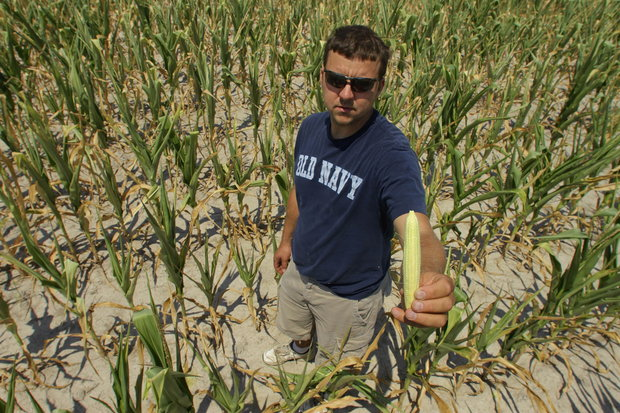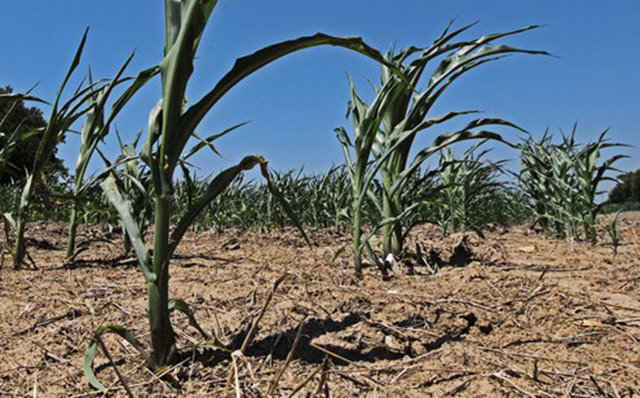Midwest U.S. ranchers cull cattle as drought shrivels crops, pasture – No relief for weeks – ‘I have never seen anything like this’
By Carey Gillam, with additional reporting by Michael Hirtzer and Karl Plume in Chicago; Editing by K.T. Arasu, John Picinich, and Sofina Mirza-Reid
13 July 2012 CENTERVILLE, Iowa (Reuters) – Ranchers are rushing to sell off some of their cattle as the worst drought in nearly 25 years dries up pastures, thins hay supplies, and sends feed costs sky-rocketing. The more desperate in the Midwest are hauling water into areas where creeks have run dry and are scrambling to secure scarce and high-priced hay to keep their cattle fed and watered. But some are giving up, or are about to. The drought in the Midwest follows another one last year in the southern Plains. The 2011 drought was centered in the heart of cattle country in Texas and helped to shrink the U.S. herd to about 91 million head, the smallest in about 60 years, while sending beef prices to record highs. A rush by ranchers to sell cattle, and in some cases hogs, could force consumers to dig deeper into their wallets next year as smaller herds can lead to higher beef and pork prices. “The blasted heat … and no rain. The drought is really drying the pastures and stuff up,” said Larry McCarty, who sold off more than a quarter of his 900-head cattle herd on Thursday. He got $100 per head less than he did a month ago as the high cost of feed has spooked away potential buyers. McCarty’s cattle were part of an auction that sold more than 500 head on Thursday in Centerville, Iowa, at the Appanoose County Livestock sale barn, said owner Clarence Ballanger. Clarence says a lot of his customers are really getting hurt by the drought. “That is a lot of people’s livelihoods … livestock.” He says there was no sign of any large-scale liquidation of cattle yet as ranchers were trying to hold on to their animals but that could change if rain does not arrive in time to save the corn crop in the United States, the world’s largest. “What will happen here – if it does not rain – we’ll probably have some big runs,” said Clarence, wearing a hat to shade him from the sun as pens of year-old black cattle breathed heavily behind him in the heat. There has been a big jump in the number of cows slaughtered in the United States. Cows are critical to growing the beef herd, fewer cows means fewer beef cattle later. In the week ending June 30, 52,700 cows were slaughtered, 3 percent more than a year ago during the peak of the Plains drought, USDA data showed. “We’re just going to get down to tiny, tiny amounts of beef available per person in the country,” said Chris Hurt, agriculture economist at Purdue University in West Lafayette, Indiana. A key and growing concern for livestock producers is the supply of hay necessary to feed the millions of cattle that are produced across the U.S. Midwest. Though hay is fed primarily through the winter months when pastures are covered in snow or are insufficient for grazing, this year, some cattlemen started feeding hay in June as their grass pastures burned up in 100-degree Fahrenheit heat. Rainfall tallies through the Midwest are well below normal for this time of year, and grassland where hay is harvested is producing roughly half of what is typical. […]
Ranchers cull cattle as drought shrivels crops, pasture 
By Carey Gillam
13 July 2012 WELTON, Iowa (Reuters) – Bob Bowman runs his hand over a slender green corn leaf here on his Iowa farm, and sighs. “This corn should be as high as my head right now, and it is only waist high,” he says, as a cool morning breeze belies the 90-degree Fahrenheit temperatures forecast to descend by afternoon in Welton, Iowa. “If we get rain real quick here, we might be down 25 percent,” said Bowman of prospective losses from the persistent dryness. “If we don’t get rain in the next two weeks, it will be a lot more serious.” Bowman farms 2,200 acres in east-central Iowa in one of the state’s highest production areas. There may not be much to brag about this year, however. After getting off to a record-fast planting pace following the mildest winter in decades in the Midwest that promised a record harvest, the corn crop got into trouble when rains became scarce, especially during pollination when yields are set. And a scorching heat wave hit the state recently. Taking a cue from a deteriorating crop, the U.S. Department of Agriculture on Wednesday cut its estimate of this year’s corn production in the United States, the world’s top grower and exporter, by 12 percent, slashing the average yield by a whopping 20 bushels to 146 per acre. Prices of corn futures at the Chicago Board of Trade have surged 40 percent this summer in the wake of the worst drought in about 25 years in the Midwest grain belt. In Iowa, the top U.S. corn-growing state, there is still time for many fields to make at least half to three-quarters of their production potential. But some are already too far gone. All of Iowa is now considered as “abnormally dry,” compared to none of the state a year ago, the U.S. Drought Monitor reported on Thursday. About 13 percent of the state is now in severe drought, with the worst-hit areas in the east-central section and southeastern corner of the state. The entire eastern half of Iowa is in at least moderate drought. Drought in the Midwest worsened over the past week, with a third of the nine-state region in severe to exceptional drought in the week ended July 10, up from about a quarter of the region a week earlier, the Drought Monitor said. The toll that the drought is taking on the U.S. corn crop is so severe in some areas of the Midwest that farmers are writing off whole fields, or fear they will soon have to. […] “The drought is very serious all the way across Missouri,” said Eddie Hamill, state director of the USDA’s Farm Service Agency. To try to aid farmers who badly need hay for their cattle, the USDA has agreed to release land in 14 Missouri counties from conservation programs and Gov. Jay Nixon has requested federal approval to release land in all 114 counties throughout the state as part of a disaster declaration. “This is the worst drought I have ever seen in my lifetime,” said Hamill. […] Neal Keppy, a 35-year-old corn grower in Eldridge, Iowa, said he’s never seen conditions this dire. Of his 1,200 acres of corn, he has lost hope for roughly half the crop. One field is so bad he has stopped treating it with fungicides and insecticides, essentially letting disease and insects take what the drought has not yet killed. “I have never seen anything like this,” he said. […]
In Iowa, hope fades as relentless drought decimates crops 
By Sam Nelson; Editing by Bernadette Baum
20 July 2012 CHICAGO (Reuters) – Extreme heat and drought conditions were set to continue baking already scorched corn and soybean crops in America’s breadbasket through early August as weather forecasts provided little hope of relief over the next two weeks. The drought will cause further damage to crops that already have been nearly decimated in some Midwest areas, an agricultural meteorologist said on Friday. Beginning in the eastern and southern Midwest, the drought has spread to the central and western areas of the region, including the top two corn producing states, Iowa and Illinois. “It will be dry and very hot in the area with temperatures in the 100s (degrees Fahrenheit) in St. Louis Sunday through Thursday, reaching 106 F on Wednesday,” said Don Keeney, meteorologist for MDA EarthSat Weather. The same scenario is expected for much of the central and western Midwest. Keeney said a little relief from the historic drought was received late this week from rainfall in the northern and eastern Midwest. However, crops in those states, especially corn, had already been significantly damaged. “There were decent rains yesterday in southern Michigan, Ohio, Kentucky and those should end today. Then another round of rain Monday and Tuesday for the north and east Midwest including eastern Minnesota, Wisconsin, northeast Illinois, central and northern Indiana and Ohio,” Keeney said. Keeney said his weather company would tour U.S. Midwest corn and soybean crops next week and expected to find extremely low yield potential from a broad band stretching from Ohio west to Nebraska.[…] The U.S. government has been slashing its condition ratings for corn and soybean crops each week and will release an updated weekly crop progress report on Monday. Crop experts and analysts have been lowering production estimates for corn and soybeans on an almost hourly basis, leading up to what will be a historic government monthly crop report on August 10. Chicago Board of Trade (CBOT) corn prices have soared 50 percent in just six weeks to a record high $8.16-3/4 per bushel late this week, surpassing the previous record of $7.99-3/4 set 13 months ago. CBOT soybeans notched record highs for three days in a row reaching a peak of $17.77-3/4 per bushel on Friday, above the previous record on Thursday of $17.49 and more than 30 percent higher than early in June. […]
